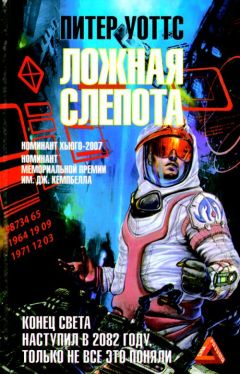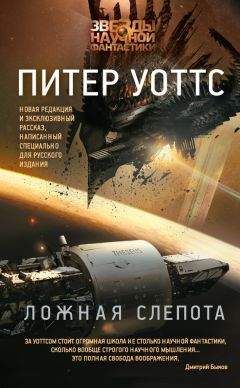Питер Уоттс - Ложная слепота
http://pages.prodigy.net/aesir/darwin.htm
90. Devlin, К. 2004. Cracking the da Vinci Code. Discover 25(6): 64–69.
91. Snir, Y., and Kamien, R. D. 2005. Entropically Driven Helix Formation. Science 307: 1067.
92. Wolfram, S. A New Kind of Science. Wolfram Media, 2002. 1192 p. Книга доступна также по адресу
http://www.wolframscience.com/nksonline/toc.html
93. Albert, M.L. 2004. Danger in Wonderland. Science 303: 1141.
94. Muotri, A. R. et al. 2005. Somatic mosaicism in neuronal precursor cells mediated bv L1 retrotransposition. Nature 435: 903–910.
95. Nelson, D. L., and Cox M. M. Lehminger principles of biochemistry. NY: Worth, 2004. (В СССР издавался оригинальный учебник Альберта Ленинджера: Ленинджер А. Основы биохимии. М.: Мир, 1985).
96. Prigogine, I., and G. Nicholis. Exploring Complexity. NY: Freeman, 1989. (Русское издание: И. Пригожин, Г. Николис. Познание сложного. М.: ЛКИ, 2008).
97. Dawkins, R. The Blind Watchmaker: Why the Evidence of Evolution Reveals a Universe Without Design. Norton, 1988.
98. Pinker, S. How the mind works. NY: WW Norton & Co., 1997. 660 p.
99. Koch, C. 2004. The Quest for Consciousness: A Neurobi ological Approach. Roberts, Englewood. CO, 2004. 447 p.
100. McFadden, J. 2002. Synchronous firing and its influence on the brain's electromagnetic field: evidence for an electromagnetic field theory of consciousness. J. Consciousness Stud ies, 9, No. 4, 2002, pp. 23–50.
101. Penrose, R. The Emperor's New Mind. Oxford University Press, 1989. (Русское издание: Пенроуз Р. Новый ум короля. О компьютерах, мышлении и законах физики. М.: ЛКИ, 2008).
102. Tononi, G., and G. M. Edelman. 1998. Consciousness and Complexity. Science 282: 1846–1851.
103. Bears, B. J. A Cognitive Theory of Consciousness. NY: Cambridge University Press, 1988.
104. Hilgetag, C. C. 2004. Learning from switched-off brains. Sci. Amer. 14: 8–9.
105. Roth, G. 2004. The quest to find consciousness. Sci. Amer. 14: 32 39.
106. Pauen, M. 2004. Does free will arise freely? Sci. Amer. 14: 41–47.
107. Zimmer, C. 2003. How the mind reads other minds. Science 300:1079–1080.
108. Crick, F. H. C., and C. Koch. The unconscious homunculus. In Neural Correlates of Consciousness-Empirical and Conceptual Questions. Ed. by T. Metzinger. Cambridge: MIT Press, 2000.
109. Churchland, P. S. 2002. Self-Representation in Nervous Systems. Science 296: 308–310.
110. Miller, G. 2005. What is the biological basis of consciousness? Science 309: 79.
111. Blakeslce, S. 2003. The christmas tree in your brain. Toronto Star, 21/12/03.
112. Matsumoto, K., and K. Tanaka. 2004. Conflict and Cognitive Control. Science 303: 969–970.
113. Kerns, J. G. et al. 2004. Anterior Cingulate Conflict Monitoring and Adjustments in Control. Science 303: 1023–1026.
114. Petersen, S. E. et al. 1998. The effects of practice on the functional anatomy of task performance. Proceedings of the National Academy of Sciences 95: 853–860.
115. Nrretranders, T. The User Illusion: Cutting Consciousness Down to Size. Penguin Press Science, 1999. 467 p.
116. Altenmüller, E. O. 2004. Music in your head. Scientific American. 14: 24–31.
117. Helmuth, L. 2003. Fear and Trembling in the Amygdala. Science 300: 568–569.
118. Dolan, R. J. 2002. Emotion, cognition, and behavior. Science 298: 1191–1194.
119. Treffert, D. A., and G. L. Wallace. 2004. Islands of genius. Scientific American 14: 14 23.
120. Wegner, D. M. 1994. Ironic processes of mental control. Psychol. Rev. 101: 34–52.
121. Proceedings of the Royal Society of London В (DOI 10.1098/rspb.2003. 2548).
122. Aiello, L., and Dean C. An introduction to human evolutionary anatomy. London: Academic Press, 1990.
123. Gallup, G. G. (Jr.). 1997. On the rise and fall of self-conception in primates. In The Self Across Psychology self-recognition, self-awareness, and the Self Concept. Annals of the NY Acad. Sci. 818:4-17.
124. Carstairs-McCarthy, A. 2004. Many perspectives, no cohcensus-a review of Language Evolution, by Christiansen & Kirby (Eds). Science 303:1299–1300.
125. Dijksterhuis, A. et al. 2006. Science 311:1005–1007.
126. Vince, G. 2006. «Sleeping on it' best for complex decisions».
Newscientist.com, http://www.newscientist.com/channel/being-human/dn8732.html
127. Devlin, A. M. et al. 2003. Clinical outcomes of hemi spherectomy for epilepsy in childhood and adolescence Brain 126: 556–566.
128. Pulsifer, M. B. et al. 2004. The cognitive outcome of hemispherectomy in 71 children. Epilepsia. 45: 243-54.
129. Moles, A., Keiffer, B. L., and F. R. D'Amato. 2004. Deficit in attachment behavior in mice lacking the Uypioid receptor gene. Science 304: 1983–1986.
130. Plane, J. M. C. et al. 2004. Removal of meteoric iron on polar mesospheric clouds. Science 304: 426 428.
131. Fitch, W. T., and M. D. Mauser. 2004. Computational Constraints on Syntactic Processing in a Nonhuman Primate. Science 303:377–380.
132. Premack, D. 2004. Is Language the Key to Human Intelligence? Science 303: 318–320.
133. Holden, C. 2004. The origin of speech. Science 303: 1316–1319.
134. Graddol, D. 2004. The future of language. Science 303: 1329–1331.
135. BBC News. 2005. Brain chip reads man's thoughts. March 31. Статья доступна по адресу:
http://news.bbc.co.uk/go/pr/fr/-/1/hi/health/4396387.stm.
136. Weng, J. et al. 2001. Autonomous Mental Development by Robots and Animals. Science 291: 599–600.
137. Von Melchner, L. et al. 2000. Visual behaviour mediated by retinal projections directed to the auditory pathway. Nature 404: 871–876.
138. Baughman, R. H. 2003. Muscles made from metal. Science 300: 268–269.
139. Weissmüller, J. et al. 2003. Change-induced reversible strain in a metal. Science 300: 312–315.
140. Piper, A., and Merskey, H. 2004. The Persistence of Folly: A Critical Examination of Dissociative Identity Disor der. Part I. The Excesses of an Improbable Concept. Can. J. Psychiatry 49: 592–600.
141. Piper, A., and Merskey, H. 2004. The Persistence of Folly: A Critical Examination of Dissociative Identity Disor der. Part II. The Defence and Decline of Multiple Personality or Dissociative Identity Disorder. Can. J. Psychiatry 49: 678–683.
142. Kaplan, F. S. et al. 1998. The Molecules of Immobility: Searching for the Skeleton Key. Univ. Pennsylvania Orthopaedic J. 11: 59–66. Статья доступна no адресу:
http://www.uphs.upenh.edu/ortho/oj/1998/oj11sp98p59.html
143. Chernoff, H. 1973. Using faces to represent points in k-dimensional space graphically. Journal of the Americal Statistical Association 68:361–388.
144. Wilkinson, L. 1982. An experimental evaluation of multivariate graphical point representations. Human Factors in Computer Systems: Proceedings. Gaithersberg. MD, 202–209.
Примечания
1
Американский писатель и журналист (p.1961): получил известность после документальной книги о геноциде в Руанде «Имеем сообщить вам, что завтра нас вместе с нашими семьями убьют». (Здесь и далее примеч. пер.)
2
Из фельетона «Заметки о будущей войне», журнал «Эсквайр», 1935
3
Тед (Теодор Рузвельт) Банди — один из известнейших серийных убийц США. Изнасиловал и убил более 30 (точное число неизвестно) женщин.
4
Американская певица и автор песен. Цитата взята из одноименной песни (сингл 1992 г.).
5
А.е. — астрономическая единица, мера измерения расстояний, равная большой полуоси земной орбиты (приблизительно 149,6 миллиона километров).




